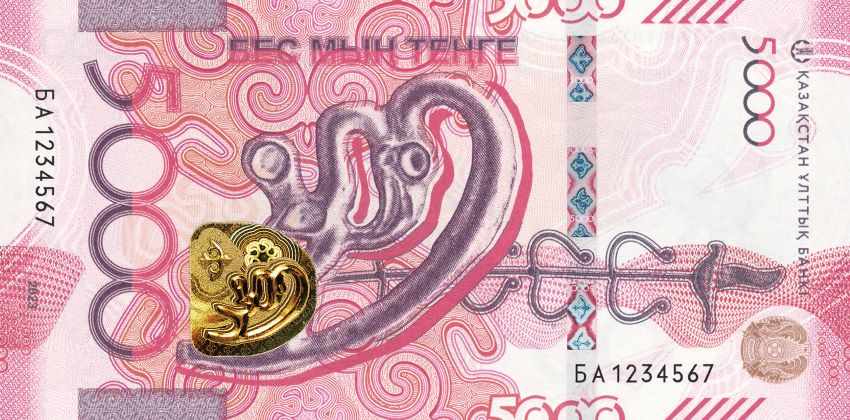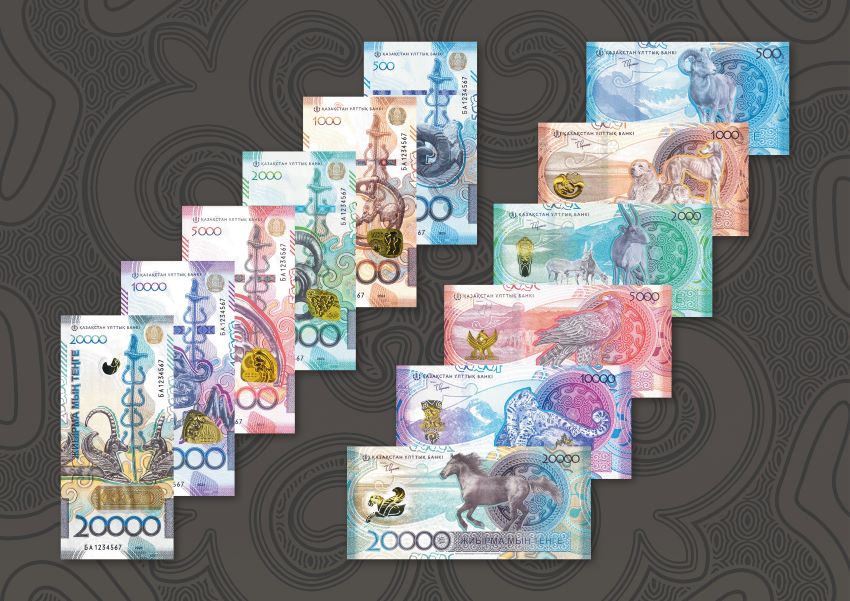



Last November, the National Bank of Kazakhstan (NBK) issued a commemorative 10,000 tenge banknote to celebrate the 30th anniversary of the national currency, followed in December by the issue of the first banknote in a new note series, the 5,000 tenge.
The NBK and its printworks, the Banknote Factory, are renowned for their pioneering approach to banknote design and feature selection, working with multiple industry partners on commemorative and house notes to test new approaches and technologies that often then make their way into circulating notes. The latest commemorative note and subsequent new series are yet another example of this approach.
Currency News™ spoke to Arman Adibayev, Director Cash Department at the NBK, and Sanzhar Nurkassimov, Chief Designer, to find out more about the latest series – the rationale, cultural factors underpinning its design, the practical steps taken to bring it to fruition and the publicity measures taken to educate the public.

Sanzhar Nurkassimov, Chief Designer (left) and Arman Adibayev, Director Cash Department (right), National Bank of Kazakhstan.
Q: Can you explain the background to the design and theme of the new banknote series?
A: In global practice, new banknotes are issued every 7-8 years with enhanced security features to prevent counterfeiting. The current ‘Kazakh Eli’ (or ‘Samruk’) series has been in circulation since 2011, and its security features have become outdated over the past 12 years. Attempts to counterfeit these banknotes have been made, with some counterfeiters successfully replicating certain security elements. This necessitates a revision of the design and security features.
Additionally, National Bank specialists have analysed the sizes of banknotes used worldwide. The results indicate that smaller-sized banknotes optimise costs and are more convenient for counting, storage, and transportation. Furthermore, this allows for faster and simpler banknote production by accommodating more banknotes per sheet. So the new notes will be smaller than those they are replacing, as well as standardised in terms of their height.
Regarding the thematic concept of the new banknote series, it is dedicated to the Saka culture, reflecting the unique worldview of our ancestors, their connection with nature, and the diverse animal world of our vast territory.
Q: Our readers won’t be familiar with the Saka culture. Can you provide some background?
A: The Sakas were a population of nomadic tribesmen who lived in the plains of Eurasia from Eastern Europe to China during the 7th and 8th centuries BCE. There were no borders at the time, but a large part of the territory is now modern-day Kazakhstan.
Many artifacts preserved in their original form from that period were discovered during archaeological excavations of ancient mounds. They included weapons, clothing and gold ornaments, which were very technically sophisticated for their time. They also included prototypes of the frequently depicted animals that still inhabit Kazakhstan and are revered by Kazakhs today.
Overall, the series aims to instill a sense of pride and interest in the population to explore their own culture and history, as well as to promote responsibility to nature.
Q: Those animals are a key feature on the new series. What was/is their significance?
A: The 20,000 tenge will feature a horse. The domestication of horses was very important to our ancestors and central to their culture, and horses remain a much loved and respected animal in Kazakhstan today.
The 10,000 tenge will feature the snow leopard, which lives in the mountains of Kazakhstan. It was hunted to near- extinction and was even listed in the Red Book (The International Union for Conservation of Nature Red List of Threatened Species), but has been successfully reintroduced. It is a totemic animal – symbolising power and grace.
For the 5,000 tenge, the species is the golden eagle, widely used for hunting in Kazakhstan, Mongolia and all Turkic nations. So important were golden eagles to our ancestors that many have been found in tombs dating to that period. For the 2,000 tenge, the chosen animal is the Saiga antelope, which was also nearing extinction and was on the IUCN’s Red Book list as well. Kazakhstan is home to three of only five populations of antelope, and a conservation program over the last 20 years has resulted in more than 2 million animals today.
The 1,000 tenge will feature two Kazakh dog breeds –the Tazy, which looks like the Saluki sighthound, and the Tobet, which is similar to the Central Asian Shepherd dog. Dogs were the best friends of the nomads – not only for hunting but also for guarding livestock from wolves.
And finally, the 500 tenge will feature the mouflon, a breed of wild sheep that inhabits the mountains and steppes of Kazakhstan.
Q: How have these and other cultural artifacts been accommodated within the design of the new series?
A: The fronts of the notes are in a vertical orientation, and the reverses are horizontal.
The fronts all feature a symbolic sacred branch with a soaring bird on top of the so-called ‘Tree of Life (a detail from the headdress of the ‘Golden Man’, a warrior from the Saka era who has been adopted as one of the symbols of modern Kazakhstan). Behind this is a decorative parametric shape in the form of a DNA spiral, which symbolises the continuity of the modern way of life with nature and history.


The front of each note also features unique artifacts based on animals from the ancient burial mounds, with a separate animal dedicated to each denomination.
On the reverse of the notes, alongside the portrait of the relevant animal is a contour of the Kazakh infinity ornament, inside of which landscape views of Kazakhstan are placed. Behind the main image of the animal is a circular Kazakh ornament comprising a shield that symbolises the protection of values; the ancient symbol representing the four cardinal points of the earth and, at the centre, a solar sign serving as a symbol of creative energy and the essence of life.
Q: What was the process of selecting the security features and integrating them into the banknote design?
A: The NBK regularly conducts analyses of the latest security features available in global practice. This allows for achieving a high level of protection for the national currency and consequently reduces counterfeiting.
The security elements in the new 5,000 tenge banknotes are based on research and development, incorporating the latest advancements in secure printing technologies.
According to a sociological study on cash usage conducted by the National Bank in 2022, it was found that 53% of respondents in Kazakhstan do not check the authenticity of tenge banknotes, and 40% cannot distinguish genuine banknotes from counterfeit ones. This prompted the search for intuitively understandable security measures for the new tenge designs.
International research indicates that the total time for checking the authenticity of a banknote is approximately 6 seconds. In a 2006 study by the Dutch central bank, a fixed interval of 2 seconds was identified for determining one authenticity element of a banknote. Another study on tactile experiments with banknotes reported that it takes the population 1-2 seconds to identify a particular pattern/element on a banknote by touch.
It was important to consider these findings and incorporate a security element that would allow the population of Kazakhstan to check banknotes during transactions within seconds.
In order to originate the concept and integrate security elements into the design of the new banknote series, the National Bank chose between several well-known companies, and the proposal from Giesecke+Devrient proved to be the most suitable for these purposes.
Thus, in creating the new 5,000 tenge banknote, the RollingStar® Patch security element was applied. Its use entails dynamic visual effects that change depending on the viewing angle. This allows users and cashiers to visually recognise and verify the authenticity of the banknote within seconds.
Furthermore, the RollingStar Patch security element provides visibility under any lighting conditions and is resistant to wear throughout the entire lifespan of the banknote.
Q: It’s always a risk using a feature for the first time. What were the decisive factors that led you to choose the RollingStar Patch?
A: The Rolling Star Patch ensures a high level of security due to its unique construction and the use of advanced printing technologies, along with its dynamic multi-coloured visual effects.
It has undergone rigorous testing and reliability evaluation by NBK experts and is compatible with existing production processes, allowing for its integration into banknote production with minimal changes to the manufacturing process.
Q: What about the other public security features, and will these be uniform across all the new series?
A: The 5,000 tenge a RAPID® Vision micro-optics windowed thread from Crane Currency with intense liquid-kinetic movement at the micron level, providing high-contrast colour movement, and a SPARK® Flow Dimension element on the reverse that synchronises with the animal on that note.
The RAPID Vision thread will be used on all the notes except the 20,000 tenge, and the SPARK Flow Dimension on all except the 500 tenge. The RollingStar patch will be used on all except the highest and lowest denominations.
In addition to these features, we also have some aids for the visually-impaired, including a series of raised lines along the long edges of the notes, the number of which denotes the denomination, and a larger high contrast denomination numeral.
Q: Working with so many partners is a complex task. How does the management of the project work, from start to launch, with these partners?
A: The launch of the new series is carried out by the team at the NBK. Several participants are involved in project management: the NBK Cash Department, the Banknote Factory of the NBK, the coordinating company Giesecke+Devrient, and suppliers of prepress materials.
The process consists of several stages:
1.Design concept creation developed by the National Bank of Kazakhstan designer and approval by management
2.Specification determination within the National Bank of Kazakhstan
3.Specification approval with the project coordinating company, suppliers of security paper, security elements, security inks, and the Banknote Factory
4.Agreement on timelines, production schedules, contract signing, and order placement
5.Origination
6.Prepress material production
7.Prototype creation
8.Signal sample production (proof)
9.Raw material delivery to the Banknote Factory
10.Banknote production
11.Shipment of the finished products to the Cash Center and valuables storage and then distribution to the branches of the NBK across the country.
Q: What is the timeline for the release of the remaining notes in the series?
A: To date, only the 5,000 tenge in the new series has been produced. All in the new series will be on paper, other than the 20,000, which was only issued in 2022 and will continue on Durasafe®. The 10,000, 2,000 and 1,000 tenge notes will be released in 2024, and the 20,000 and 500 tenge notes in 2025.

Q: Is cash still important as a payment instrument in Kazakhstan?
A: A survey carried out at the end of 2022 involving 10,000 people and small businesses showed that 60% still use cash for daily payments and 72% use their card to withdraw cash.
The average annual growth of cash in circulation over the past five years has been 9.8%. During 2023 cash in circulation increased from 3.7 to 4.1 trillion tenge.
This trend underscores the continued significance of cash as a critical payment instrument.
Q: Why did you issue a commemorative banknote immediately before the new series?
A: A good question. 2023 marked 30 years of the tenge – an important anniversary for a young currency. We wanted to celebrate that and did so with the design featuring a map of all the regions of Kazakhstan, making people proud of our country, along with different ornaments showing the diversity of our culture.
We also wanted to try out new security features – which is something we tend to do with our commemorative banknotes, and also occasional house or specimen notes that we produce. The feature we tested in the commemorative note was a varifeye® ColorChange patch over a window, which is in the shape of a coin and can be seen from both sides of the note. We plan to use this feature in the new 10,000 tenge.
Q: How have you gone about promoting the new series and educating the public?
A: We have created a lot of material for the mass media, including digital assets in the form of a series of videos that both explain the design ethos and cultural significance of the notes by linking the Saka culture to present-day Kazakhstan (Ed: worth viewing –it’s fantastic) and, in other videos, describe the specific design and security features.
We have made extensive use of social media –such as TikTok, Telegram, Instagram – and these have been posted on both our own platforms and those of the commercial banks, who have also showcased them in their banking halls for customers to view.
Over the course of two months the materials have been viewed over 460,000 times – over 70,000 times on the NBK’s social media platforms, 210,000 times in mass media outlets and over 180,000 times on the social media platforms of the banks.
Q: Any other final considerations about this project you would like to share here?
A: The launch of a new series involves many processes both within the NBK system and externally, particularly in working with second-tier banks, which requires specific skills and experience. The most important aspect, of course, is the attentive approach to working with the population.
We are sincerely delighted with the successful collaboration with professionals in their field, such as renowned companies and leaders in the global market like Giesecke+Devrient, Crane Currency, Landqart, and SICPA.
Our joint work is not yet complete; there is much ahead of us, but the results are already visible and speak for themselves.
Each new project brings new experience and opens up new horizons, and we sincerely believe that our work will be appreciated by end users.